2011
In 2011, in a development welcomed by PMNT, New Zealand joined the EAAFP, with DOC appointed the government agency with responsibility for the Partnership.
During its involvement with the flyway, PMNT has sought any opportunity to raise the profile of migratory shorebirds. Any way of developing and fostering links with other regions in the flyway was of interest to us. One such opportunity came through links with education authorities in Busan, South Korea. In 2009 we hosted a delegation from Busan Education Department who were here to explore ways of forming partnerships between schools in the two countries. PMNT subsequently met with teachers from local schools who were enthusiastic about the project. This initiative bore fruit in February 2011 with the arrival of students and teachers from two schools in Busan to participate in joint activities with two local schools, Parawai in Thames, and Birkdale Intermediate in Auckland.
2012
Woodley represented PMNT at the 6th Meeting of Partners of the EAAFP at Palembang, Indonesia, where he briefed partners on PMNT aspirations to continue shorebird survey work in North Korea. That the New Zealand government was directly represented at a Meeting of Partners for the first time was a welcome development.
Riegen joined Queensland’s Peter Driscoll in September for a five-day aerial survey along 400+km of the Gulf of Carpentaria coastline in a light plane as a reconnaissance for a major expedition planned for 2013.
2013
In March and April, Riegen, Woodley and Kristelle Wi from Pūkorokoro Miranda were in the Gulf of Carpentaria on the first expedition to the region since 1999. More New Zealand red knots were seen but not as many as expected. The count work undertaken helped cement recognition of the Gulf of Carpentaria as the third most important shorebird site in Australia. Riegen then continued down the Queensland, NSW and Victorian coasts looking for and finding more marked birds from New Zealand.
In May, a delegation from the State Forestry Administration and Provincial Forestry departments in China visited the Shorebird Centre for a workshop on shorebirds and community involvement in conservation.
In June Lawrie represented PMNT at the 7th meeting of Partners of the EAAFP, in Alaska, where the grave situation for Red Knots on the northern coast of Bohai Bay in China was emphasised. Red Knot are New Zealand’s second most numerous Arctic shorebird and use this part of the Yellow Sea as their major staging site
In November Woodley participated in a workshop in Seosan, South Korea on the Development and Operation of Wetland Education Centres, in Seosan, South Korea. The primary outcome of the workshop was a comprehensive manual on developing wetland education centres, applicable worldwide. It was published online in May 2014.
In December, Woodley participated in a workshop hosted by WWF Hong Kong, to develop an Action Plan for Shorebirds in the flyway. The overriding theme emerging from the workshop was that time was running out for many shorebird populations dependent upon stopover sites in the Yellow Sea. The Action Plan was due to be presented to the governments of China and South Korea in 2014.
Also in December the Shorebird Centre hosted a visit by a delegation from the DPRK in association with the DPRK-New Zealand Friendship Society.
2014
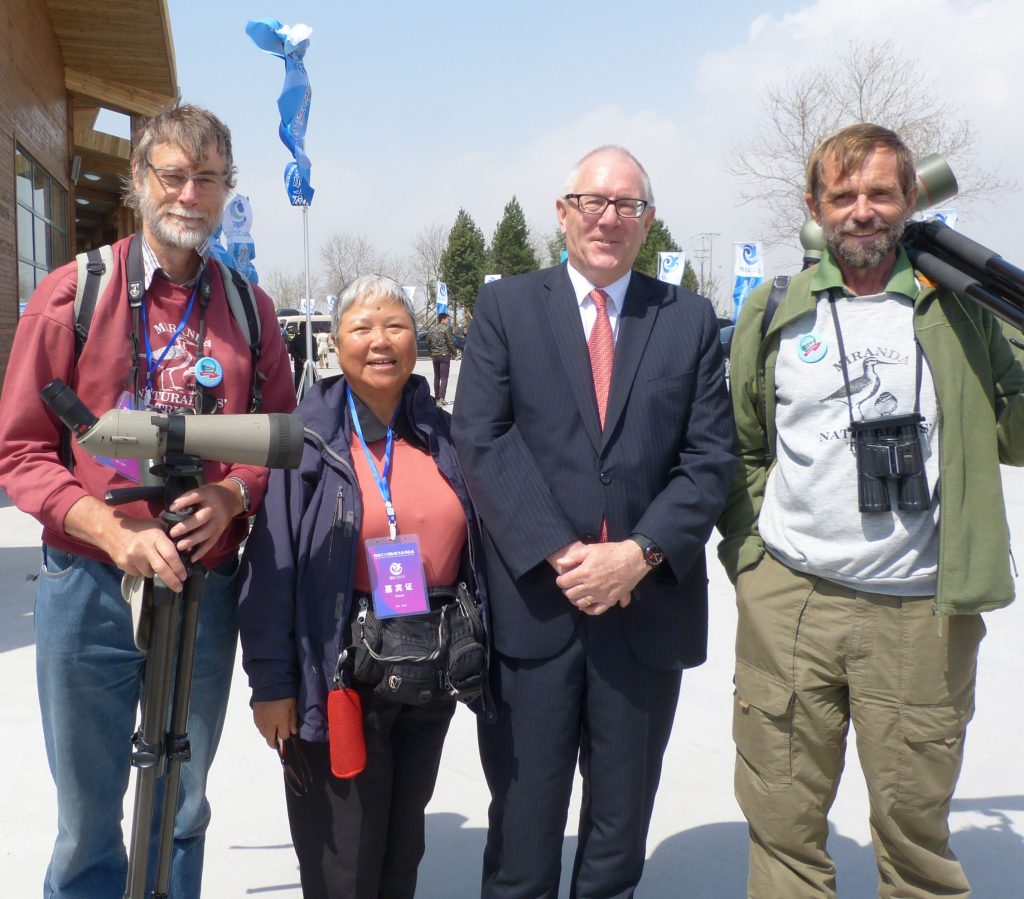
For PMNT the involvement of the New Zealand government in the EAAFP bore fruit in 2014 when a joint DOC-PMNT delegation travelled to Yalu Jiang, funded by the Ministry of Foreign Affairs and Trade under the Seriously Asia programme. The major objective of the visit was to launch a report based on 10 years of shorebird count data from the Yalu Jiang reserve. Compiled by Adrian Riegen, Gillian Vaughan and Ken Rogers, in association with colleagues in China, the report showed Yalu Jiang to be the most important shorebird staging site in the entire East Asian-Australasian Flyway. The launch ceremony at Donggang on 4 May was attended by Carl Worker, New Zealand Ambassador to China, and Pan Shuang, Vice-Mayor of the city of Dandong.
The ambassador’s presence was highly significant as it substantially raised the profile of the event and drew a higher level of representation from Beijing. The delegation then held talks with officials from a number of agencies in Beijing, including the State Forestry Administration and the Ministry for Environmental Protection.

The delegation then travelled to Pyongyang, DPRK where they met with officials from the Nature Conservation Union of Korea (NCUK). PMNT and NCUK signed an agreement to work jointly for shorebird conservation in the two countries, including a three-year programme of shorebird surveys in the DPRK to begin in 2015. This was subsequently increased to five years.
The delegation made a one-day visit to the Luannan coast of Bohai Bay where they met with the Global Flyway Network (GFN) team, and investigated the issues relating to Red Knot. Riegen returned a week later for several days to help the GNF team scan for marked birds from Australia and New Zealand.
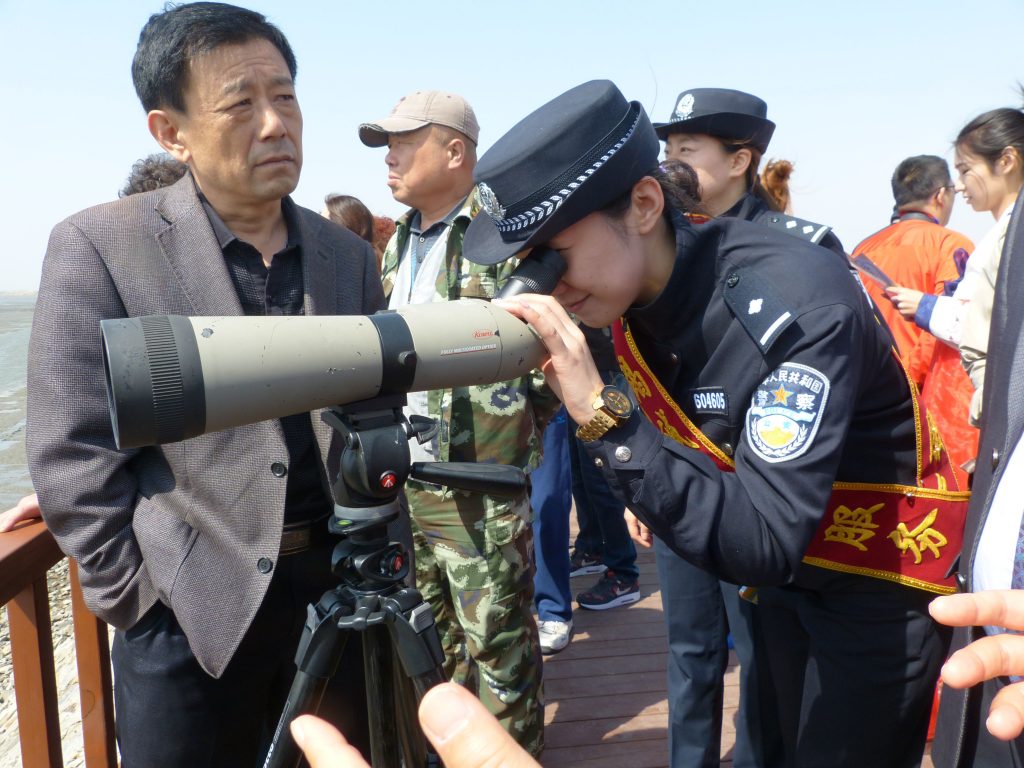
2015
In January David Lawrie represented PMNT at the 8th Meeting of Partners of the EAAFP at Kushiro in Japan.
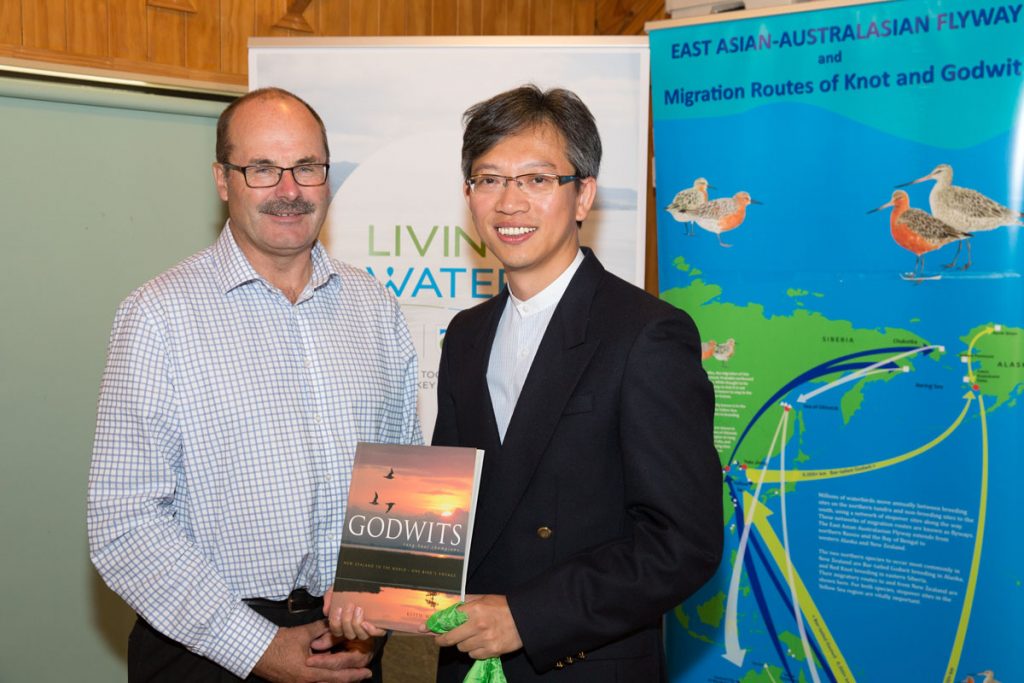
In March, the Chinese Ambassador to New Zealand Mr Wang Lutong visited Pūkorokoro Miranda accompanied by DOC Director General Lou Sanson. The ambassador was briefed on our engagement with the Flyway, our partnership with YJNNR and also on the serious decline of the Red Knot populations in the Flyway. He was particularly interested to learn of the critically important stopover site for knots on the Luannan Coast of Bohai Bay, as he comes from Hebei Province.
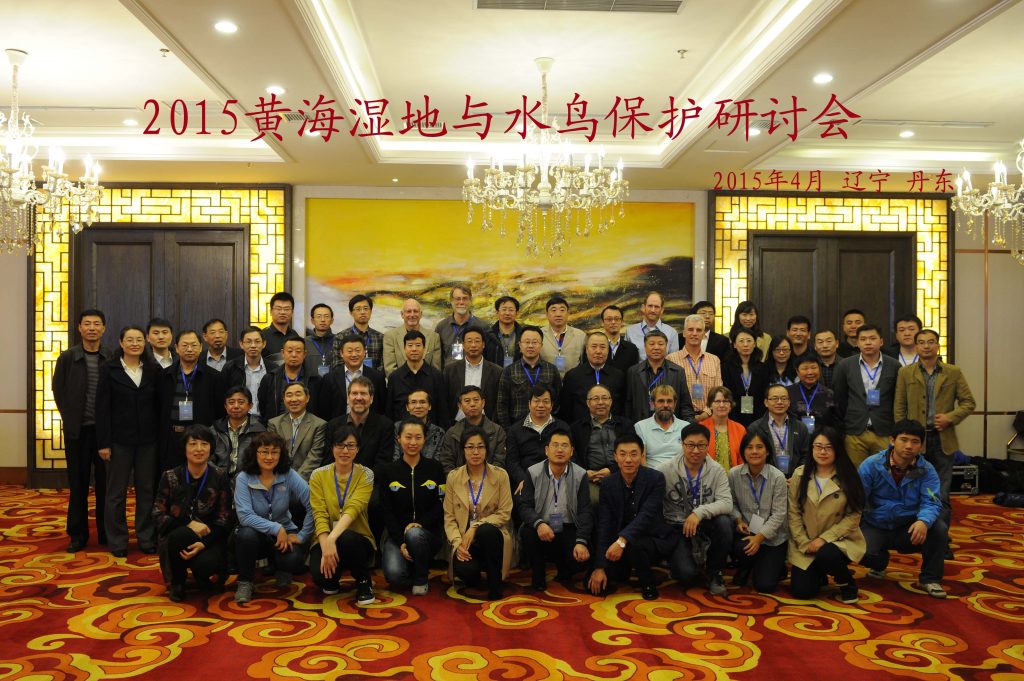
In April Riegen, Woodley and PMNT Council member Estella Lee returned to YJNNR. Activities included a partial survey of the reserve, a school visit and participation in a bird festival.
They then travelled to Beijing where they met with New Zealand Ambassador John Mackinnon to brief him on migratory shorebird issues.
Riegen and Woodley, joined by PMNT member David Melville then travelled to Pyongyang to commence the four year programme of shorebird surveys in DPRK. A 50 km section of coast northwest of Nampo was investigated, during which over 20,000 shorebirds were recorded, including 2000 Bar-tailed Godwits. Birds banded in northern Australia, China and Alaska were recorded. No New Zealand bands or flags were seen but this was not unexpected as by early May ‘our’ birds would have already departed for their breeding grounds in Alaska. Discussions with NCUK officials resulted in plans for next year to include investigating benthic life on the intertidal flats (i.e. what are the birds eating?) and school visits.
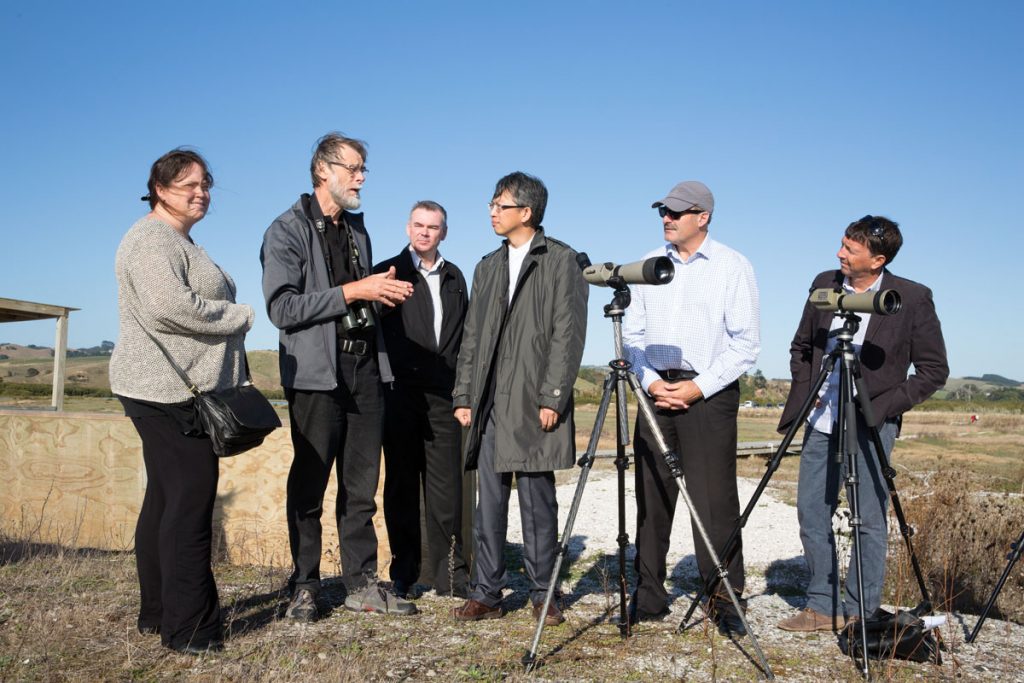
In October Ambassador Wang returned to Pūkorokoro Miranda accompanied by then Conservation Minister Maggie Barry. It was clear that since his visit in March he had been actively engaged in addressing the red knot issue, pointing out that a provincial level reserve had been proposed for the area surrounding the knot stopover site in Bohai.
In November Riegen accompanied a delegation to China led by Lou Sanson. A series of high level meetings were held with central government officials in Beijing. The delegation met with the State Forestry Administration, State Oceanic Administration, and the Ministry for Environmental Protection. There were also discussions with the provincial government of Hebei Province. The main purpose of the visit was to engage with the different authorities and look for ways to protect the key 7km of Luannan coast on the Bohai that is vital for Red Knots. The meetings were all very positive and timely, as all departments are now having to include environment protection planning in their new 5 year plans. There is increasing optimism that real conservation outcomes for migratory shorebirds in China can be achieved. A welcome development on this occasion was that local iwi Ngati Paoa were represented in the New Zealand delegation.
2016
In January PMSC hosted a delegation of management and technical staff from Yalu Jiang.
In March PMSC hosted a ceremony at which Vice-Minister of the China State Forestry Administration Chen Feng Xue and DOC Director General Lou Sanson signed a Memorandum of Agreement to work towards protection of shorebirds and their habitats.
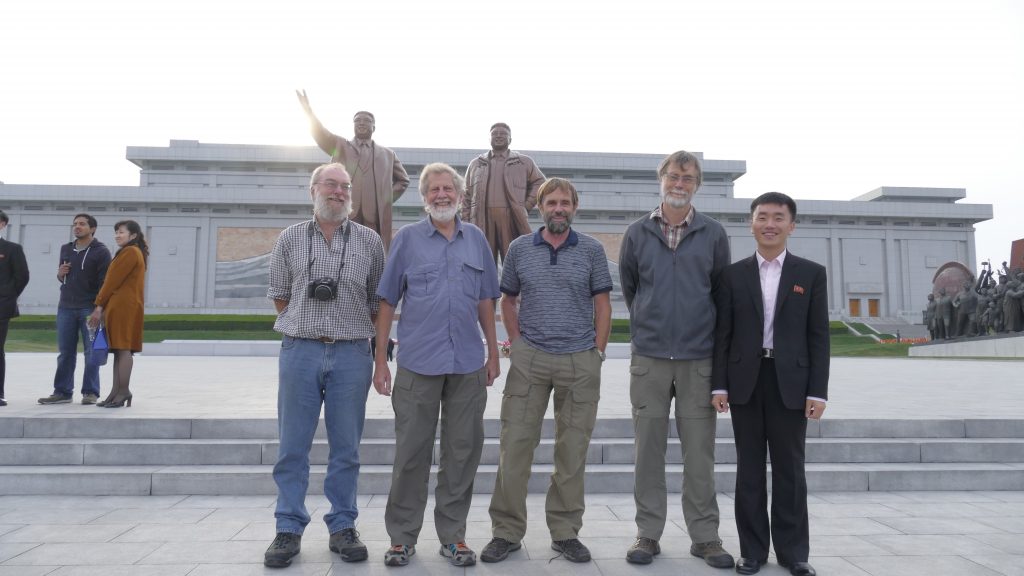
In mid-April Riegen, Woodley, Melville and Bruce Postill returned to DPRK and surveyed a section of coast north of the 2015 survey site. This included a return to Mundok, the reserve visited by the team in 2009. Three further sites of international importance were identified.
2017
In January Lawrie represented PMNT at the ninth meeting of Partners in Singapore.
In April Riegen, and Melville were joined by Nigel Millius and Wendy Hare for this year’s expedition. A section of coast northwest of Mundok was surveyed and 38,000 shorebirds counted. Three additional sites classified as internationally important were located. In addition, a banding training session was held in which 6 birds were caught with mist nets and banded. This was a first for our DPRK colleagues.
In early May Riegen accompanied the New Zealand Ambassador to Beijing on a visit to the Luannan Coast Red Knot site. Accompanied by a significant number of Chinese officials, this was another successful profile-raising event, with the ambassador later describing it as his best day in China.
There are several indications that increasing recognition of the importance of the Yellow Sea region for shorebirds is occurring in China. In June 2017, the government of Hebei announced a coastal reserve would be created which encompasses the Luannan site. In early 2017 the Chinese government announced it was seeking World Heritage status for most of the major shorebird sites in the region. It is clear that the long-term efforts of PMNT have clearly contributed to this outcome.
In October NCUK staff spent 10 days on and around Sindo Island on the Chinese border where they investigated potential survey sites and logistics ahead of our proposed field season there in April 2018. It was proposed to conduct a simultaneous shorebird survey of the border region by two teams: one of PMNT and NCUK staff in NK and the other of PMNT members and Yalu Jiang staff in China.
2018
In April 2018, a larger PMNT team of Riegen, Melville, Woodley, Postill, Hare, Milius and Estella Lee returned to Dandong, this time accompanied by a TVNZ film crew. Riegen, Melville and Woodley together with the TV crew crossed over to Sinujiu, while the others remained in China. The DPRK team travelled to Sindo at the mouth of the Yalu, where they were the first ever foreigners to overnight on the island. They found significant areas of coastal wetland – tidal flats and reed beds largely unaffected by development – supporting large flocks of shorebirds. This was fascinating habitat that is almost completely gone from the rest of the Yellow Sea coast and is well worth preserving. It is believed this is what the Jiangsu coast of China would have looked like in the 1960s, as well as much of the Yellow Sea coast 100 years ago. 13,000 Bar-tailed Godwits, 3895 Far-eastern Curlews, and 2690 Eurasian Curlews were counted, making the site internationally important for all three species. With so much habitat lost elsewhere around the Yellow Sea, the coast of DPRK assumes critical importance as shorebird refugia.
Simultaneously the team in China counted the sites at the eastern end of the Yalu Jiang Reserve.
A program on our work in DPRK called Secret Stopover screened on TVNZ in May, to an audience of over 600,000. It continues to be talked about two years later.
In December Lawrie represented PMNT at the tenth meeting of Partners in Hainan, China.
2019
In April Riegen, Melville and Woodley returned to DPRK to complete the fifth of the five shorebird surveys outlined in the PMNT agreement with NCUK. The primary focus was to visit sites in South Hwanghae Province. Neither of the southern sites held internationally important numbers of shorebirds on the days they were visited. However, the nature of the overall area suggests it could well support internationally important numbers of birds. It is hoped to investigate this further on a future visit. The team was able to revisit two sites in North Pyongan Province covered in the 2017 survey. This was two weeks later in the migration season than in 2017. As expected, numbers of birds were down but still there were still significant numbers of Dunlin and Far Eastern Curlew.
The team was also able to visit and make presentations at two senior schools in Pyongyang.
2020
The intention was to return to DPRK in April to present the PMNT/NCUK report documenting the results of five years of surveys. It was also planned to revisit the area in South Hwanghae Province, as well as return to Sindo, but the Covid-19 pandemic prevented this.
